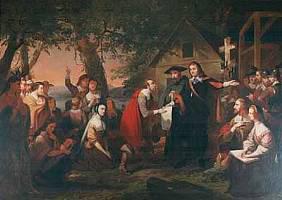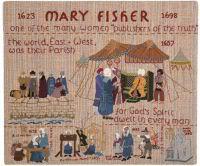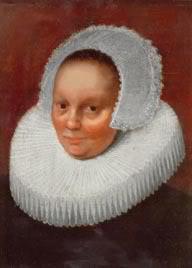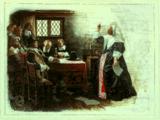American Author and Civil War Nurse Louisa May Alcott was born in Germantown, Pennsylvania on November 29, 1832, the second daughter of Abigail May, women’s suffrage and abolitionist advocate, and Bronson Alcott, philosopher and education reformer. Louisa and her three sisters, Anna, Elizabeth, and May were educated by their father, and spent their childhood in Boston and Concord, Massachusetts. When Louisa was 10, Bronson enlisted the family in an experiment in communal living on a tract he named Fruitlands, because of its orchard. Six months of Transcendental agriculture left the Alcotts destitute, Bronson suicidal, and the Alcott marriage on the verge of dissolution. A distressed Louisa recorded it all in her childhood diary. At age 15, troubled by the poverty…

Verlinda Graves Stone
Calvert Presents Acts of Toleration to Governer Stone The Year: 1648 Verlinda Graves was born about 1618 in England. William Stone was born in England around 1603. He came from a well-known merchant family in London. William came to America in1628 with a group of Puritans who settled on the eastern shore of Chesapeake Bay in Virginia. Verlinda and William were married in the 1630s in Virginia, and they had seven children. The Stones were successful in the Chesapeake, and respected by their neighbors. William worked as a merchant and planter. He was appointed justice of the peace, and then sheriff in Accomack County, and a burgess in the Virginia Assembly. The settlement thrived there, but eventually came into conflict…

Margaret Jones
Accused Witch in Boston It seems that when we think of witches we automatically think of Salem, but colonial Boston experienced a number of witchcraft episodes during the seventeenth century. Witchcraft involves the use of supernatural powers such as clairvoyancy, invisibility, flying, and the ability to kill at a distance. A witch is usually viewed as one who manipulates unexplainable forces through spells and other rituals. Belief in witchcraft was prevalent in Europe, and scores of people had been convicted and put to death in England during the 1640s. Stories of those proceedings reached the New World, and led the people of Boston to fear for their own safety.
Sophia McClelland
Sophia McClelland was a Civil War nurse who was determined to go out onto the field of battle and retrieve the sick and wounded. In the autumn of 1861, she saw wounded soldiers lying near a train platform. She took them to a nearby hotel and brought food and blankets from her own home to help care for them. She enlisted the help of wounded soldiers to serve as nurses, because at times there were few nurses available. Sophia McClelland Sophia wasn’t afraid to challenge the male chauvinism that existed in the Civil War era. She was touched by the needs of the wound, and she was amazed at the ferocity with which she stood up for her patients. She…

Mary Fisher
The Year: 1656 Image: Panel B2 of the Quaker Tapestry, which was devoted to Mary Fisher Quaker Beginnings In the 17th century, the Quakers – also known as the Society of Friends – were a form of Protestant Christianity that was started by George Fox in England in 1652. According to tradition, Fox was standing on Pendle Hill in northwest England when he received a vision from God directing him that instead of simply obeying doctrines and rules, he should focus on the Inner Light—the ability of every person to directly receive God’s love. George Fox believed there was no need for ordained ministers and traditional forms of worship, and began to preach this new form of Christianity throughout England….

Anneke Jans
Dutch Woman in New Amsterdam Anneke Webber was an early Dutch colonist in New Amsterdam and New Netherland. She was born in Norway in 1605. She married Roeloff Jans in Amsterdam, Holland, on Friday, April 18, 1623. They had six children. Her name became well-known because of the many lawsuits concerning her farm, which was claimed by her heirs and the Trinity Church in New York City. The Dutch West India Company founded the colony of New Amsterdam—later New York City—in 1625 as a place to defend river access to the company’s fur trade operations in the Hudson River, which extended to the colony of New Netherland—later New York state.
Women and Girls in the Browns Island Explosion
Women and Children Killed in Explosion The Confederate States Laboratories (CSL) was located on Brown’s Island in the James River in Virginia. The brainchild of Confederate ordnance chief Colonel Josiah Gorgas, the CSL made small arms and ammunition for the Confederate Army. Image: Monument to the Women and Girls in the Browns Island Explosion This gray granite marker now stands beside the gazebo in Richmond’s Oakwood Cemetery. The names of those who perished and their ages are engraved on the back. Because most of Richmond’s men were serving their country at the front, women and children were the bulk of the workforce at CSL, from the age of twelve to sixty. Their hands were small and well suited to assembling…

Slavery in Rhode Island
Rhode Island Slaves Image: Narragansett Planters Painting by Ernest Hamlin Baker, 1939 A grist mill and sacks of corn being towed by oxen – most of the harvested grain was likely kept in the Colony for consumption by the planters and their livestock. Rhode Island established the first law regulating slavery on May 18, 1652, as part of the Acts and Orders of the General Court of Warwick. It stated that the blacks or whites forced to serve another must be freed after 10 years after arrival in Rhode Island. The fine for noncompliance was 40 pounds. The law was evidently never enforced, because African slaves were in the Colony that same year. The demand for cheap labor had prevailed.

Margaret Brent
Women in Law: First Woman to Appear in Court Image: Margaret Brent before the Maryland Assembly Margaret Brent ranks among the most prominent women figures in early colonial history. Hailed as an early feminist who advanced the legal rights of women, Brent was the first woman in the American colonies to appear before a court of the Common Law to claim land in her own right or to pursue her own interests in court. She was also a significant founding settler in the early histories of the colonies of Maryland and Virginia. Margaret Brent was born around 1601 in Gloucestershire, England, into a wealthy Catholic family, one of thirteen children. She was an early American feminist, a major colonial landowner…
Harriet Jacobs
African American Abolitionist and Author Harriet Jacobs escaped from slavery and became an abolitionist speaker and reformer. Jacobs’ single work, Incidents in the Life of a Slave Girl, published in 1861 under the pseudonym Linda Brent, was one of the first autobiographical narratives about the struggle for freedom by female slaves and an account of the sexual harassment and abuse they endured. Harriet Ann Jacobs was born in 1813 in Edenton, North Carolina to Daniel Jacobs and Delilah. Daniel was a mulatto slave owned by Dr. Andrew Knox. Delilah was a mulatto slave owned by John Horniblow, a tavern owner. Harriet inherited the status of slave from her mother—if the mother was a slave, the child was a slave. That…